Windows 7: Release Candidate 1 Preview
by Ryan Smith and Gary Key on May 5, 2009 11:00 PM EST- Posted in
- Systems
Giving Windows a Facelift: New GUI Features Abound
Last, but certainly not least on our whirlwind tour of Windows 7 RC1 is the new GUI. Although we’ve listed a number of significant changes Microsoft has made to the internals of the OS for Windows 7, it’s the GUI changes that Microsoft is pushing the heaviest. By reworking the GUI Microsoft it shooting to improve the GUI responsiveness, along with adding more features to keep parity with Apple in the eye-candy wars. It also doesn’t hurt of course that with these GUI changes Windows 7 looks a good deal less like Windows Vista, which helps Microsoft keep attention off of Vista when it comes time to talk about Windows 7.
Anchoring the GUI changes is the new Windows 7 taskbar, which marks the biggest change to the taskbar since it was introduced in Win95. In a nutshell, the taskbar just became a whole lot more like Mac OS X’s Dock. Application entries on the taskbar have been collapsed to just their icon by default, with multiple instances of an application sharing the same icon representation. This is combined with the new pinning ability, which replaces Quick Launch shortcuts. When an application is pinned to the taskbar, it will launch in-place; in other words the pinned item is now its active taskbar item rather than a separate item being created on the taskbar. This makes the new taskbar operate nearly the same as the Mac OS X Dock, which pioneered this behavior several years ago.
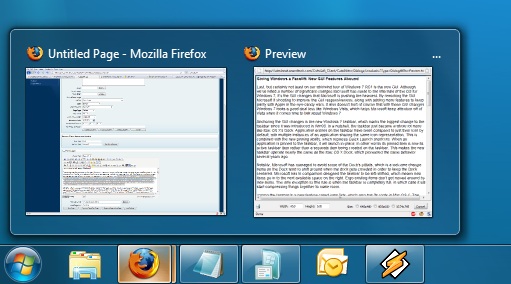
Handling multiple instances of a single app
Notably, Microsoft has managed to avoid some of the Dock’s pitfalls, which is a welcome change. Items on the Dock tend to shift around when the dock gets crowded in order to keep the Dock centered. Microsoft in comparison has designed the taskbar to be left-shifted, which means new items go into the next available space on the right. Ergo existing items don’t get moved around by new items. The only exception to this rule is when the taskbar is completely full, in which case it will start compressing things together to make room.
Joining the taskbar is a new feature called jump lists, which also has its roots in Mac OS X. The jump list replaces the normal right-click menu that comes up when clicking on an item in the taskbar, and is based around the concept of the jump list containing custom controls for an application, alongside the generic window manipulation options. A screenshot works better than words here, so let’s start with that.
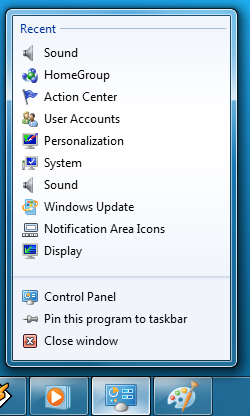
The Control Panel Jump List
As an application needs to be coded to take advantage of jump lists, any advanced functionality that moves beyond window manipulation is limited at this point to the handful of Microsoft applications implementing jump list support. The most common use for jump lists will be showing recently used items for a specific application, which in turn is intended to replace the Recent Items collection in the Start Menu (it’s still there but it’s disabled by default). Thus far a couple of applications, most notably Windows Media Player, have implemented further jump list functionality, also serving proof of concept implementation for 3rd party developers. The WMP jump list includes music controls while the Getting Started control panel lists all of its component items as tasks.
Jump lists also show up in the Start Menu, where recent applications with jump list support will have those lists available as a sub-menu attached to the application. The boys (and girls) at Microsoft seem rather proud of jump lists, but their success is largely out of Microsoft’s hands. For jump lists to be successful in the long run, developers need to start using them such that a critical mass is reached and jump list use becomes a standard feature. In spite of having similar functionality in Mac OS X, Apple has never pushed the issue and as such few programs use their implementation and few people even know it exists.
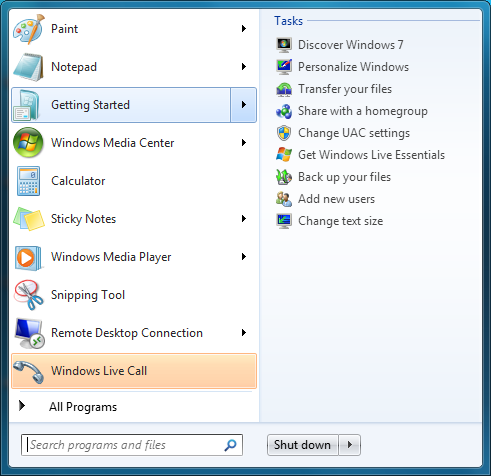
Jump Lists in the Start Menu
Also new are two window management features, Aero Snap and Aero Shake. Neither of these are Exposé clones (come on guys, you could take the dock but not Exposé?) so we’ll get that out of the way right now. With Aero Snap, Windows now recognizes when windows are being dragged to the edge of the screen, and treats that as a special action (not unlike Mac OS X’s hot corners). When a window is dragged to the top of the screen it’s maximized, and when a window is dragged to the left or the right it’s enlarged/tiled in such a way that it takes up the half of the screen it was dragged to. Pulling a window away from the side of the screen that it was dragged to reverts the window back to the way it previously was.
Meanwhile Aero Shake is the more oddball of the new window management features. When you shake a window (I’m being serious here) it causes all other application windows to become minimized. Shake the window again, and everything is restored. To Microsoft’s credit we're not immediately aware of any exact analog to this features (perhaps Mac OS X’s Hide All?) so it’s certainly unique. Whether it’s useful however….
It should be noted that while both of these features have “Aero” in the name, they’re not actually tied to Aero and the DWM. They work just as well with the Basic GUI, albeit without the eye-candy animations.
Gadgets have been relocated as of Windows 7. They’re no longer constrained to the Windows Sidebar (which has gone away completely) and can now be placed anywhere on the desktop, similar to how Yahoo! Widgets operates. As the Sidebar always felt out of place in Vista, this is a nice change to how gadgets are dealt with on Windows. With the removal of the Sidebar the internal workings of the gadget feature have also been tweaked – gadgets no longer get their own process and instead share a single process. This helps Microsoft in achieving their goal to bring down Windows’ memory usage, but it means that a rogue gadget can bring down the rest. Meanwhile gadget-haters will be glad to know that with the Sidebar gone, and the OS no longer loads the gadget process (which is still called sidebar) by default. The process is only fired up when a gadget is attached to the desktop, saving yet more memory and shaving a few seconds off of the Windows boot time.
With the change in gadget functionality, one last new feature has been added to the taskbar (and as a keyboard shortcut) to make it easier to access the gadgets. Aero Peek, as Microsoft calls it, is a small button on the right of the taskbar that makes all application windows transparent when hovered over, allowing users to see (i.e. peek at) the gadgets on their desktop without actually messing with any application windows. Clicking the button then minimizes all application windows so that users are free to interact with the gadgets (or anything else on the desktop for that matter), and clicking it again restores the application windows.
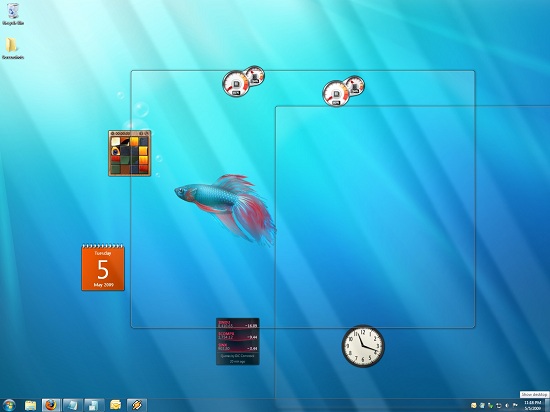
Using Aero Peek To Look At the Gadgets
This specific feature makes interacting with the gadgets much more like Mac OS X’s Dashboard, which is a separate space where only Mac OS X widgets reside. There’s a big difference in keeping gadgets/widgets on the desktop versus in a separate dashboard, but with the addition of Aero Peek the absolute functionality becomes quite similar. The desktop in this case is Windows’ dashboard.
As for the Start Menu, it has not seen any big changes for Windows 7, but it has seen some minor functionality reduction. For those hold-outs still using the classic Start Menu, it has finally been removed with Windows 7. The modern Start Menu is now the only option.
Finally, the overall theme of the GUI has been changed for Windows 7. Gone is the pea green highlighting and artwork found in various Explorer and Control Panel panes, to be replaced with a more neutral blue/grey styling reminiscent of Apple’s metal themes. If something was green by default in Vista, it’s blue by default in Windows 7. Most of the color choices in Windows 7 can be adjusted through themes just like it could with Vista, although like Vista some items are static images and as such Windows 7 always retains some of its blue styling.
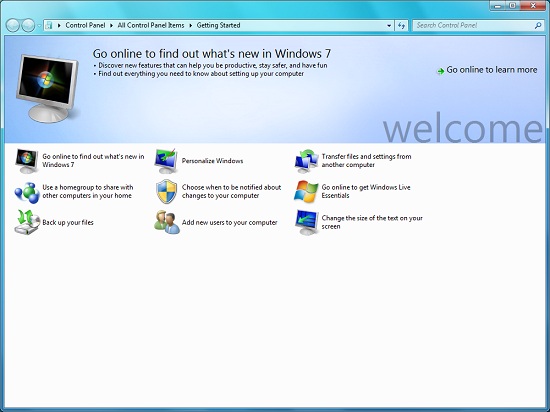
The new Welcome Screen, an example of the Windows 7 GUI style
The ribbon interface from Microsoft Office has also made its way over to Windows 7, showing up in a handful of applications. Paint and WordPad are the most prominent examples of this change, as the use of ribbons required a facelift for each. The ribbon has been pretty popular with users once they become accustomed to it, so it’s likely that Microsoft will continue to slowly deploy it in more applications as time goes on. Presumably it will become the dominant interface in Windows at some point in the future.



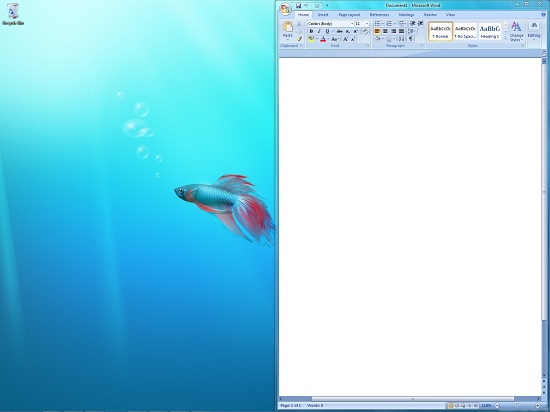
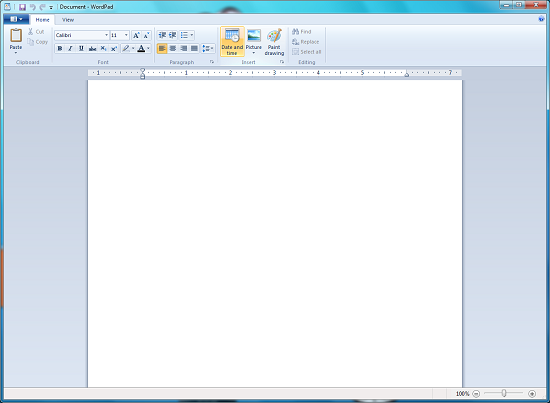








121 Comments
View All Comments
Bmadd - Wednesday, May 6, 2009 - link
I see the graphs, i see the new features and i honestly cant be the only person who doesn't want to change from my Vista x64 install? Can i? i got a dual core and 4gig of ram, a dash of tweaks and moving the pagefile and everything loads within a second of running. I personally dont see how going from vista to 7 for me can be a thought when there gonna give me the only thing i care for in 7 and thats DirectX11 and the new aero features. Thanks MSSazar - Wednesday, May 6, 2009 - link
Why not?It's free to use and try. If you don't like it, go back.
I have switched both my HTPC and my main rig to Windows 7 simply because it is a more efficient way for me to work. The homegroups sharing features is miles better than the old, archaic sharing method and the new Media Center interface is fantastic.
Also, Windows 7 loaded up all the drivers I needed by default, including both of my Hauppauge TV Tuner drivers and it just worked.
I see a lot of naysayers nit-picking, which is fine. However, I have yet to see anyone point out anything meaningful that should disuade people from either using Vista or Windows 7.
Btw, for me, the biggest selling feature, beyond the vastly improved 10 foot interface in MCE, was Aero Peak. Can't go back to Vista now without that functionality :)
Bmadd - Wednesday, May 6, 2009 - link
Well i have never really used gadgets, widgets and such. There not for me like myspace and twitter aren't for me. I would hate to change to win7 after setting me vista install up so nicely only to not like it and have to spend time getting it back to the sleak thing it is at the moment.Perhaps i will download the RC and just keep it there till Win7 is released and drivers are all sweet, install RC on a new hard drive and go from there but i am fair to pleased with my current vista install to consider changing
papapapapapapapababy - Wednesday, May 6, 2009 - link
not a single feature that i want or even care about. how about a good competent fast image viewer? more drm? giant icons? no classic ui? terrible. just give me a smaller, faster, stronger and more efficient xp or gtfo ms.TonkaTuff - Wednesday, May 6, 2009 - link
Microsoft should count themselves very lucky that Apple remains uninterested in being the OS for everyone and restrict themselves to the premium OS and hardware market.Yeah Snookie Im sure apple holds themseves back from over 90% of the O/S market based on there morals and lack of interest in making more money. What kind of deranged fanboy are you? Comments like the one above show how brainwashed some of you looney tunes are becoming.
It really is scary and you should seek professional help.
A comment in the article really hit the nail on the head,
MANY PEOPLE SAY THEY HATE VISTA BUT FEW CAN ACTUALLY SAY WHAT THEY HATE ABOUT IT.
Yeah Vista had issues when it first was released, it was a major step from the XP O/S but that was 2 bloody years ago. Ive been running Vista on my Gaming rig and my Work Laptop and a server/seed box and in 12 months I havnt had 1 crash that was the O/S's fault, Not one crash, not one BSOD, probably 4 or 5 freeze ups that had to be end tasked in 12 months on 3 systems numbering well over a 1000 hours of use, not even XP could claim to be that stable.
Like any O/S it has its annoyances, they all do (yes snookie even your precious mac).
Do I expect Win7 to be much different from Vista? No not really, I expect it will be a dressed up and refined version of Vista.
Why would Microshaft do such a thing, they just want more money, why not release it as a service pack for Vista?
BECAUSE THEY HAD TO CHANGE THE NAME AND MAKE IT OUT TO BE DIFFERENT FROM VISTA BACAUSE OF ALL THE LEMMINGS OUT THERE THAT HATE VISTA BUT DONT KNOW WHY THEY HATE IT!!!!!!!!!!!
End of rant.......Snookie you sir are a sychotic applemac fanboi, get help for god sake.
squeezee - Wednesday, May 6, 2009 - link
Microsoft has said to developers (at PDC at least) that Direct2D and DirectWrite along with the rest of DirectX 11 functionality will be available on windows Vista.fendell - Wednesday, May 6, 2009 - link
Has anyone tested Windows 7 and Ventrilo (any version) over some time?It's the only thing that keeps me on 64bit XP at the moment, because ventrilo has this weird behaviour on windows 7 where it suddenly doesnt recieve data for 2-5 minutes, then suddenly gets everything at once, this is veery frustrating and in fact raidbreaking in wow ;)
nycromes - Wednesday, May 6, 2009 - link
I have also used Windows 7 RC for WoW raiding and have had no major issues. Ensure you are running it as an administrator. I had a few issues before doing that, but none like you are describing. I am using a USB microphone and a standard soundcard speaker combination with no issue.vectorm12 - Wednesday, May 6, 2009 - link
I use ventrilo for wow a couple of times per week, at times for hours without any issues on build 7077x64(correct me if I'm wrong, found on piratebay.org btw). However I do use a USB connected wireless Microsoft headset(looks like the 360 one but grey) which might have some impact as it works like a second soundcard.snookie - Wednesday, May 6, 2009 - link
If you think XP is the best OS ever then you haven't used very many. It is archaic."The biggest news is that the Ultimate/Business/Home Premium schism has been resolved with Windows 7."
This is a pretty amazing statement seeing as how it took a further paragraph to partly but not fully describe what all the versions are for.
The Start Menu remains a horrible user interface designed by committee. Just awful.
Windows 7! Now with even more DRM!!!
UAC is an attempt to place responsibility for security too much on the user which is why it was so intrusive. A certain amount of user action is reasonable but UAC went far beyond that.
WTF, why does IE 8 take up so much space with its headers? Seriously Microsoft do you have no idea at all about usability? Slapping a ribbon interface on a simple text processor is just dumb.
Mail, Calendar, and Movie Maker might as well have been removed because they suck. But their removal points out even more how Microsoft needs its own version of iLife.
ISO implementation is so Microsoft. Half-ass as usual.
Why does Windows 7 need a disk defragmenter in 2009? No other modern OS does.
Virtual Windows XP? Is this a joke? Probably won't run on older machines which is where it is needed most and even more headaches for desktop admins for configuration and administration.
Why would you do performance testing on an SSD drive which very few desktop boxes have these days?
Looks like Windows 7 will suck on laptops as much as Vista does. Not good news since so many notebooks are sold these days.
My recommendation to Corporations is that for the 95% of users who need basic functionality they replace Windows entirely with a locked down Linux of some form. Many that I have worked with are considering this very thing and I have no doubt the Windows 7 will hasten this decision. XP requires far too intensive support ( yes i know your handbuilt game tower never has to be rebooted with XP, sure it doesn't).
Microsoft should count themselves very lucky that Apple remains uninterested in being the OS for everyone and restrict themselves to the premium OS and hardware market and that an unrestricted Linux desktop is still to complicated for most users. more and more companies are providing their high end IT Architects and Developers with Macs and they are happily snapping them up. I have seen this at Cisco, Oracle, Motorola, and may others. When Visual Studio using .NET developers would rather use a VM on OS X t do their development there is something very wrong and I'm seeing a lot of that.
The authors really do not understand the relationship between development tools, threads, the kernel, and processor usage.